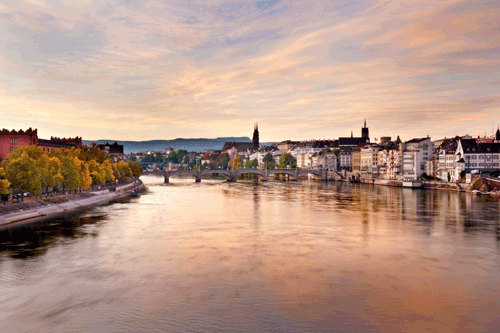
Basel on the Rhine
photo © Andreas Zimmerman
courtesy of Basel Tourist Board
©2012
Last year I published two interviews in Epicurean-Traveler.com with Basel’s two top chefs, Peter Knogl and Tanja Grandits. Not to diminish their talents and charm, but Basel, all too often underrated, with its beautiful medieval Münster (cathedral), built between 1019 and 1500 in Romanesque and Gothic style on a hilltop overlooking the Rhine, and town center with winding cobble-stoned streets, and a carnival that ranks with New Orleans, and Rio without the vulgarity, is a great travel and business-convention destination for lots of reasons, not only but also for its two top culinary stars.
Located in northwest Switzerland on the river Rhine in the Dreilälanderecke (three countries’ corner) where the Swiss, French and German borders meet, Basel, with a population of less than 200,000 people, is the third largest city in Switzerland after Zurich and Geneva and the nation’s only cargo port. Thus besides its own attractions it can serve as a good entry point to the Alsace, Black Forest, and Jura mountains.
Thanks first to its Mittlere Bridge, an easy walk across, built in 1225-6 and for centuries the only bridge over the Rhine south of Cologne, and then to the Church Council held here from 1431-1449, Basel has been a commercial and cultural center for several hundred years. Today amongst many other events its fair grounds host Art Basel, the world’s premier fair for modern classics and contemporary art, and in late March-early April BaselWorld, the world largest watch and jewelry trade fair.
Basel’s university, the first in Switzerland, was endowed in 1459 by the Sienese humanist Pope Pius II, who reigned from 1458-64 and is the only pope ever to have written his autobiography. Here such notable scholars as the Dutch humanist, priest and theologian Erasmus of Rotterdam (1466-1536) — known as “the crowning glory of the Christian humanists” — and the Swiss Renaissance physician, botanist, alchemist, and general occultist Paracelsus (1493-1541) taught. During this same time period apprentices of Gutenberg introduced the new craft of printing to the city. The Schwabe publishing house was founded here in 1488 by the German typographer Johannes Petri (1441-1511) and is the oldest publishing house in the world still in continuous business.
Today the city prides itself on hosting nearly forty museums, which together with the city’s trade fairs, account for Basel’s well over one million visitors annually. The museums’ contents cover a diverse spectrum of subjects.
The Toy and Doll House Museum, which houses the largest collection of teddy bears, some 2,500 (the oldest ones dating back to 1904) in Europe, was founded by Maya Oeri, one of the eight great-grandchildren heirs of the local Roche pharmaceutical company and owner of the Basel football team. Its touch-screen monitors explain the history of teddy bears and other toys in several European languages.
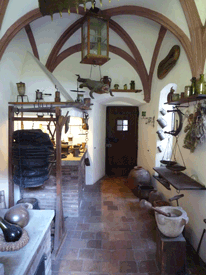
The Pharmacy Museum, Basel, photo ©2012 by Lucy Gordan
The University’s History of Pharmacy Museum complete with ancient Egyptian amulets, alchemistic laboratories, pharmacy interiors, and obsolete medicines such as snake excrement to prevent warts, is housed in a medieval house, once the home of Johannes Amerbach and Johannes Froben, two of Basel’s early typographers, as well as of Erasmus. Another museum in a medieval setting is the hands-on paper mill dating from the Council and still in use, although recently restored, where visitors can learn the trades of paper manufacture and typography.
It’s not surprising to find the Jewish Museum of Switzerland in Basel, because it was the birthplace of Zionism. The first Zionist Congress, convened and chaired by Theodor Herzl, was held here from August 29-31, 1897. The museum, which aims to introduce visitors to Jewish customs and ceremonies, exhibits valuable items depicting religious and everyday life. These include tombstones, medieval documents, Hebrew books printed by the famous Basel typographers, and mementos from Zionist Congresses. Another fascinating museum, formerly a convent church, is the Historical Museum of Basel which spotlights the city’s role as the crossroads between the three local cultures: Swiss, German and French. Its highlights include numerous Pre-Reformation sacred artifacts, in particular the Basler Totentanz (Dance of Death) and the Basel Cathedral Treasury.
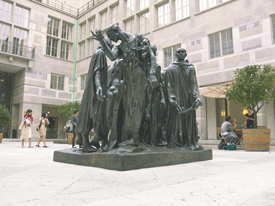
Courtyard of the Kunstmuseum
This high density of museums compared to other cities of similar size is the result of closely interwoven private and public collecting and promotion of the arts and culture going back to the 16th century. For example, the art museum orKunstmuseum Basel, then calledAmerbaschsches Kabinett, was opened to the public in 1661 and is the world’s oldest public art collection in continuous existence. It boasts the largest selection of works by the Holbein family in the world, the largest collection of prints and engravings in Switzerland, major Renaissance paintings by Witz, Cranach the Elder, Grünewald, a significant number of Impressionistsm especially van Gogh, Gauguin, and Cezanne, and 20th-century works by Picasso (a whole room full), Braque, Leger, several German Expressionists, and Andy Warhol.
Directly across from the Kunstmuseum Basel on the main downtown street, St. Alban-
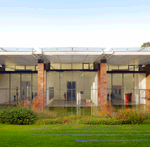 Beyeler Foundation museum |
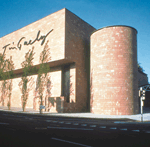 Tinguely Museum 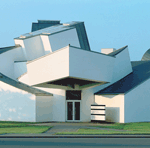 The Frank Gehry designed Vitra Design Museum |
Graben, is the Antikenmuseum Basel und Sammlung Ludwig housed in several “protected” small landmark 19th-century houses. Founded in 1961 and opened in 1967, thanks to the support of many local scholars, businessmen, and collectors, and then enlarged in 1981 because of the generosity of German chocolate magnate and voracious art collector Peter Ludwig and his wife Irene, it’s the only Swiss museum devoted exclusively to the ancient civilizations of the Mediterranean region, particularly Greece, with artifacts from the 4th millennium BC to the 7th century AD, most dating from 1000 BC to 300 AD.
Since the late 1980s various private art collections have been made accessible to the public, such as the Beyeler Foundation museum, designed in 1997 by Renzo Piano from Genoa. Well-worth a 15-minute ride on the no. 6 tram to the suburb of Riehen, it started as the private collection of art dealer Ernst Beyeler, and today boasts a Who’s-Who of Painting since the 19th century. Another private collection is the Italian-Swiss Mario Botta’s Tinguely Museum, containing works spanning some forty years by the important 20th-century Swiss artist of the same name. The Vitra Design Museum, housed in architect Frank Gehry’s first European building, is one of the world’s leading museums of industrial furniture design and architecture.
Other important city sights include the Cartoonmuseum Basel, the only museum in the world devoted exclusively to satirical art, both caricature and comic; Switzerland’s largest collection of musical instruments; the Ethnological Museum, one of Europe’s grandest collections of European and non-European cultural life; the University’s Botanical Gardens, founded in 1589, the oldest botanical gardens in German-speaking countries and famous for its collections of orchids and cacti; and Switzerland’s first zoo (1874), affectionately known as “Zolli,” world-famous for its breeding of endangered species and Basel’s most visited paid tourist attraction.
If you prefer the outdoors it’s possible to discover Basel on your own thanks to five self-paced walks, between 30 and 90 minutes in length with audio guides in several languages, available from Basel Tourist Board, following in the footsteps of its most famous residents: Erasmus, historian Jacob Burkhardt, professor Thomas Platter, Paracelsus, and Holbein. Another nice pastime is a walk along the Rhine on the “Riviera,” a ferry ride across the Rhine to the opposite bank, or a cruise down-river. Still other outdoor pleasures are the city’s numerous (170), the most amusing being Tinguely’s “Nonsense” near the main square Barfüsserplatz.
Also not to be missed is the ancient Roman settlement Augusta Raurica, founded c. 44 BC by the Roman legionnaire Julius Caesar Lucius Munazius Plancus. Although some 15 miles east of the city, it’s easily reached from downtown by train to Kaiseraugst or the number 70 bus. The largest archeological park in Switzerland, it was once a prosperous city with some 20,000 inhabitants, and the capital of this Roman province for the first two centuries AD. Its highlights are the most imposing Roman theater north of the Alps, a Roman house, and a museum with the largest silver treasure of late antiquity.
No self-respecting Swiss city can be without its chocolatier. The best in Basel is Schiesser on the Marktplatz. There you’ll also find the best läckerlei or ginger wafers, a local specialty.
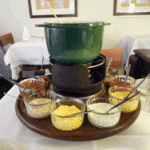
Fondue Bacchus, photo © Lucy Gordan
Besides Peter Knogl’s Cheval Blancwith two Michelin stars in the Grand Hotel Les Trois Rois (Three Kings) Hotel, and Tanja Grandit’s Stucki with one Michelin star in the
elegant suburb of Bruderholz overlooking Basel, another must is the Fondue Bacchus at the centrally-located Safran Zunft, housed in the spice traders’ guildhall. Yet another is elegantChez Donati with its beautiful view over the Rhine and magnificent collection of modern art — some of it by former patrons (it used to be Andy Warhol’s favorite hangout when he came to ArtBasel). The fare is northern Italian. I recommend the ossobuco.
As for hotels, hands-down the best in town is the deluxe Les Trois Roisoverlooking the Rhine, a favorite of Napoleon, Goethe, Theodor Herzl, Queen Elizabeth II, Thomas Mann, Picasso, and the Rolling Stones. A member of the Leading Hotels of the World, it is one of the oldest and finest hotels in Switzerland. According to legend, the hotel owes its name to the three kings who made peace in Basel in 1026. Just down the street is the design boutique Hotel D, opened a couple of years ago. Another splurge is the Teufehof, a renovated medieval mansion where a different artist designed each room. Other comfortable choices are the Schweizerhof and the Euler, newly refurbished though still old-fashioned in atmosphere. Both are across the square from the main railroad station. In the Euler’s lounge a Russian-born concert pianist entertains from teatime to midnight and accepts requests.
Downtown Basel is quaint with its winding cobble-stoned pedestrian streets, so the best transportation is by foot, but another Basel perk for tourists is the “mobility card” for free public transport. Every hotel issues them for the length of a guest’s stay. There’s no need to stamp it or even show it unless during a spot-check. Don’t forget it at the hotel because if caught without it, there’s an 80 franc fine. Electric trams and buses take you wherever you want to go and each stop has an electric screen with its name, the number of the bus or tram in arrival and how many minutes you need to wait.
The most festive times to visit Basel are during advent, when I went to visit the city-wide Christmas market, the largest and most traditional in Switzerland, or during Carnival orBasler Fasnacht, which the locals consider “die drey scheenschte dääg” or “the three most wonderful days of the year.” Unlike carnivals elsewhere, which end on Mardi Gras, the height of Basel’s comparatively somber festivities with its bands, floats, costumes, and special foods, such as zweibelkuch (a kind of quiche) and mählsuppe (a soup made with sautéed flour), starts on the Monday (morgestraich) after Ash Wednesday and ends 72 hours later. The opening event, an eerie procession through the old town, begins at 4 AM sharp and lasts for two or three hours. Tuesday is the day of children and of the Guggemusig, noisy brass bands that play intentionally off key. On Tuesday night at 10 PM, dozens of these bands play on two stages at Clarplatz orBarfüsserplatz. Gemütlichkeit!
& & &
Lucy Gordan is an award-winnning travel writer and cultural journalist living in Rome, where she is Epicurean-Traveler.com’s Bureau Chief. She can be reached at gordan@attglobal.net. Her website is www.lucygordan.com.
Links to other recent articles by Lucy Gordan:
